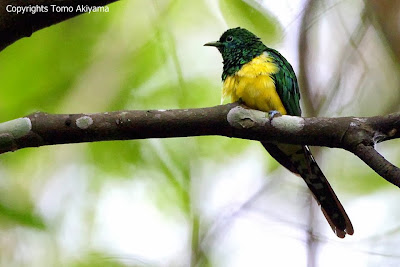African Emerald Cuckoo
(Chrysococcyx cupreus)
Photo by Tomo Akiyama
Enjoy his beautiful photo from here (Wildlife Japan)
Where can I find
African Emerald Cuckoo in Uganda?
Press "read more" for the full Script of the program
18. African Emerald Cuckoo Chrysococcyx cupreus
NFA
bird Podcast: I am Johnnie Kamugisha. The bird for today is the African Emerald
Cuckoo.
They
are 23cm long that is from the beak to the tail.
An
adult male of this bird is a stunning emerald-green above and yellow on the
belly unlike any other bird.
I
remember seeing it in very good light with my friend Patrick Cardwell and his
better half Marie-Louise Cardwell and we all agreed it looked varlvet.
In
flight, it shows black and white underwing coverts and dark flight feathers.
The
female African Emerald Cuckoo is barred rufous and green above and barred white
and green below.
The
African Emerald Cuckoo lives a solitary life, but is wide spread and a common
resident of moist forest.
I
can say it has got a stable population trend since there is no evidence for any
declines or substantial threats even though it has never been quantified.
It
has got a very distinctive call that can't be mistaken for any other bird often
translated as Hel-lo geor-gie.
They
prefer patching up and calling from the canopy and it may take you a few
minutes to the bird even though they are brightly coloured.
They
are brood parasites
like any other cuckoo.
They
tend to parasitise Robins and Thrushes.
It
is said that they are able to feed on hairy caterpillars because they pill off
the stomach skin full of the hairs, push it out and a new one grows.
The
African Emerald Cuckoo can be found almost in all forests like Budongo, Kibale,
Echuya among others.
The
bird for today is the African Emerald Cuckoo and am Johnnie Kamugisha.
References:
-Bird of East Africa (Book),
-IUCN Red list http://www.iucnredlist.org/details/22684021/0
-The Birder's Handbook (Paul Ehrlich, David Dobkin, and Darryl Wheye. 1988. Simon and Schuster, New York)




No comments:
Post a Comment